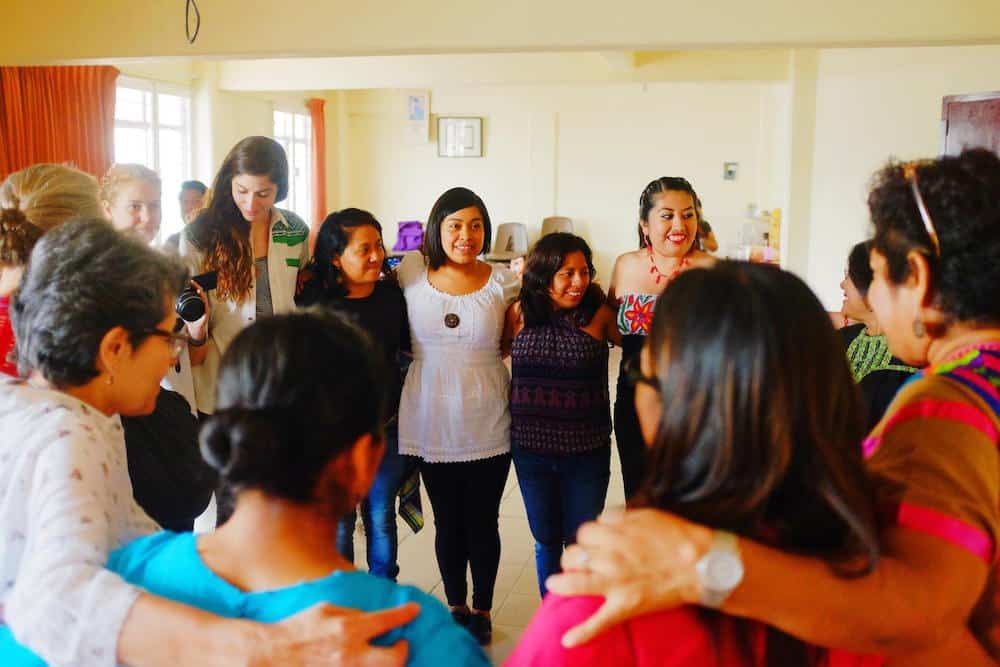On a warm 2017 summer day in Oaxaca, Mexico, Daniela Bermea huddled around a easel of drafting paper with almost a dozen other women. With markers in hand, they brainstormed a long list of title options for the collective photo project created during a three-month seminar called “Community intervention in favor of maternal health.” Eventually, the women narrowed the experience down to one word: renacer, the Spanish word for rebirth.
“They chose that word because it represents the social change that the women are trying to bring about in their communities,” said Bermea, who is in the master of social work program at the Steve Hicks School of Social Work. “The second piece was that it reflects the need to repaint maternal health beyond raising awareness.”
Throughout the summer, Bermea facilitated a community-based participatory research seminar in Oaxaca, conceived through the efforts of a local NGO (GESMujer), a local research center (CIESAS-Pacífico Sur), and the Steve Hicks School of Social Work. She conducted the research seminar as an independent study, for which she received an E.D. Farmer International Fellowship.
Bermea worked with 11 indigenous or Afro-Mexican women, aged 19-30, with the specific aim of using participatory methods to explore maternal health issues in each woman’s respective community in the Mexican state of Oaxaca. One of those methods was photovoice, through which community members utilize photography and stories to explore, in their own terms, issues they deem as important.
“Every single one of their experiences and their communities were different,” Bermea said. “Some [participants] focused on adolescent health, some focused on midwives in the community, while others focused on teen pregnancy and a lack of contraceptives. It really varied, and through their community assessment they identified what they wanted to work on.”

Bermea became interested in maternal health in Oaxaca after participating in a global research study abroad program in 2016, through The University of Texas at Austin. During this program, she did an internship in a hospital because of her interest in obstetrics and gynecology.
“I got to experience maternal health from the inside of the hospital, which was really impactful to me,” she said. “I wanted to continue working and learning about the subject in Oaxaca because I saw a lot of overlaps with maternal care in the United States. My initial goal was to try to find that connection between Texas and Mexico.”
While there are many initiatives in Mexico that have significantly improved the state of maternal health care in recent years, Bermea said, there are still challenges for women living in rural and indigenous communities.
“You have gender inequities, race inequities, and class inequities essentially, and when they all intersect, they affect the quality of care,” Bermea elaborated.
Bermea built on what she had learned about maternal health care during her study abroad program for her work with GESmujer in the summer of 2017. She facilitated sessions, conducted focus groups, and secured the funding to buy digital cameras for photovoice. After training the women in how to use the cameras, participants returned to their respective communities to photograph people, places, or objects related to their chosen topics in maternal health care.
The topics varied greatly, and challenged conventional notions of what constitutes maternal health.
“When people think of maternal health, they often think of the time period when a woman is pregnant because that’s when they’re going to become mothers,” Bermea said. “In our seminar, we approached maternal health using a life-course perspective. We defined maternal health as starting at the point where a woman is inside the womb of her own mother. It starts there because everything that she is experiencing and every experience up until they do become mothers themselves shape their health and affects their health outcomes.”
The women reconvened every other weekend in the city of Oaxaca, and Bermea would facilitate a conversation around the issues the women identified. Bermea found that photovoice specifically allowed women to articulate cultural norms that posed challenges to maternal health.
She remembered one participant who interviewed a husband who said he worried his wife would get involved with another man if she was using contraceptives. Another told the group, “I just recognize that we’re not in charge of our own bodies here. The man is. They hit us and treat us like we’re just sexual objects.”
“We had one participant tell us that in her community, a man became a man when he got a woman pregnant,” Bermea said. “And for a girl to become a woman, she had to become a mother.”
Through photovoice, women were able to engage in a dialogue about gender equality that empowered them to seek positive change in their personal relationships as well as their communities, Bermea said.
Bermea added that the seminar guided participants on how to use their specific interests and skills to develop activities in their respective communities. For example, one woman created an action plan for how to use her talent in community theater to educate her community about gender issues and access to contraception.
“The seminar was full of capacity-building, training, and education that it might have been inaccessible in any other way,” Bermea said. “Through this process, they learned how to do a community assessment, mapping, conduct interviews, how to formulate an action plan. Now they have all these tangible skills for any job they’re interested in pursuing or for continuing this work.”
For Bermea, the collaborative nature of the experience was groundbreaking because academic institutions, community members, health providers and NGOs “met in a middle ground.”
“This is how we should be addressing health issues,” she said. “We’re all having a conversation at the same table which allows us to identify the deepest roots of health disparities and the actions we can take using the resources that we have available to us.”
By Lynda Gonzalez. Posted June 28, 2018.

